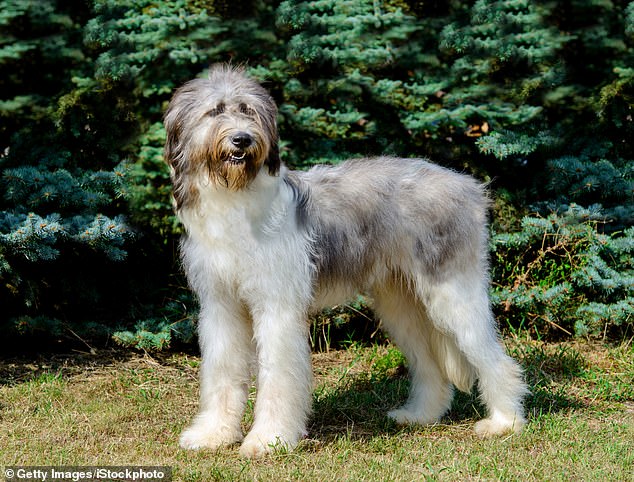[ad_1]
From mountains of dog food to unexpected trips to the vet, looking after man’s best friend can often be expensive. And some cost much more to keep than others
According to experts, the Romanian Mioritic shepherd dog is the priciest pooch to own, costing £16,250 over its lifetime.
On top of an average £511 initial cost, this dog would set you back £104 per month for its entire 13-year life expectancy.
That includes a whopping £5,789 spent on food alone, over nine times more than the £610 cost of feeding a Chihuahua for life.
At the other end of the scale, the English toy spaniel proves to be the most affordable breed for British dog owners.
These small dogs cost £5,163 over their 11-year lifetime, or just £39.12 per month.
Tom Sadler, managing director at Pet Insurance Deals, which conducted the analysis, says: ‘While cost shouldn’t be the only consideration, understanding the long-term financial commitment can help prevent heartbreaking situations where owners must surrender pets they can no longer afford to care for properly.’

The most expensive dog breed in the UK is the Romanian Mioritic shepherd, which costs £16,250 over its lifetime

The UK’s cheapest dog breed is the English toy spaniel, which costs just £5,348 over its 11-year life span
Size is one of the biggest factors in determining a dog’s cost, with seven out of the 10 most expensive breeds weighing over 36kg (80lb).
Following the Romanian Mioritic shepherd, which can weigh up to 60kg (130lb), the next most expensive dog is the 27kg Hamiltonstovare, which costs £14,951 over its 15-year lifetime.
This is followed by the Estrela mountain dog, which weighs up to 50kg (110lb) and costs £14,778.13 to own over its life span.
Smaller dogs, meanwhile, are significantly cheaper to keep.
The cheapest dog, the English toy spaniel, weighs no more than 6.3kg (14lb) at its very largest.
This is followed by the Japanese Chin, which costs £5,348 over its lifetime and weighs 1.8-3.2kg (4-7lb).
Likewise, the pomeranian costs as little as £5,594, or £33.30 per month, and weighs just 2kg (4.5lb).
However, medium breeds offer the best value for money in terms of cost relative to average lifespan.

The Hamiltonstovare is the second most expensive breed, costing £14,951

The third most expensive breed is the Estrela mountain dog, costing £14,778
Dogs like the border collie and Australian cattle dog cost £8,676 and £9,328 respectively, but live for 13 to 14 years on average.
These cost differences are largely due to the increased cost of feeding significantly larger dogs.
A large dog might need to eat between 500 and 600 grams of food per day, compared to the 80 to 100 grams required for small breeds.
But some breeds have different dietary requirements, and the costs of feeding can vary significantly between breeds.
For example, the central Asian shepherd dog requires £37.67, while the similarly sized Belgian Malinois requires just £25.74 of food every month.
Another big factor for the overall cost is grooming, with some dogs requiring frequent professional treatment.
Breeds that require specialist treatments like hand-stripping, a method involving pulling dead hair from dense-coated dogs by hand, can cost over £1,740 just to groom.
The Afghan hound, the fourth most expensive breed, costs £1,925 in grooming costs over its lifetime.

Long-haired dogs such as the Afghan Hound can cost up to £1,925 just for their grooming

Smaller breeds such as the Japanese Chin, costing only £5,348, were much cheaper due to the smaller amounts of food needed
Insurance costs can also be a big factor in determining how much a dog costs to keep.
Since certain breeds are more prone to health conditions or congenital disorders, they are expected to have higher medical costs and larger insurance premiums.
For example, the Afghan hound costs owners £2,227.68 in illness and accident insurance over its lifetime, nearly triple the amount for some smaller breeds.
Likewise, the Romanian Mioritic shepherd dog costs £2,361 to insure over its lifetime compared to just £700.80 for a Kuvasz, despite both being large breeds.
These total expenses often dwarf the initial cost of purchasing a dog, which typically ranges from £400 to £500 for pedigree breeds.
Mr Sadler says: ‘The financial aspect of pet ownership often surprises new dog owners who haven’t factored in the long-term costs beyond the initial purchase.
‘We recommend budgeting not just for routine expenses but setting aside emergency funds for unexpected veterinary care, which can be substantial regardless of breed.’
[ad_2]
This article was originally published by a www.dailymail.co.uk . Read the Original article here. .

